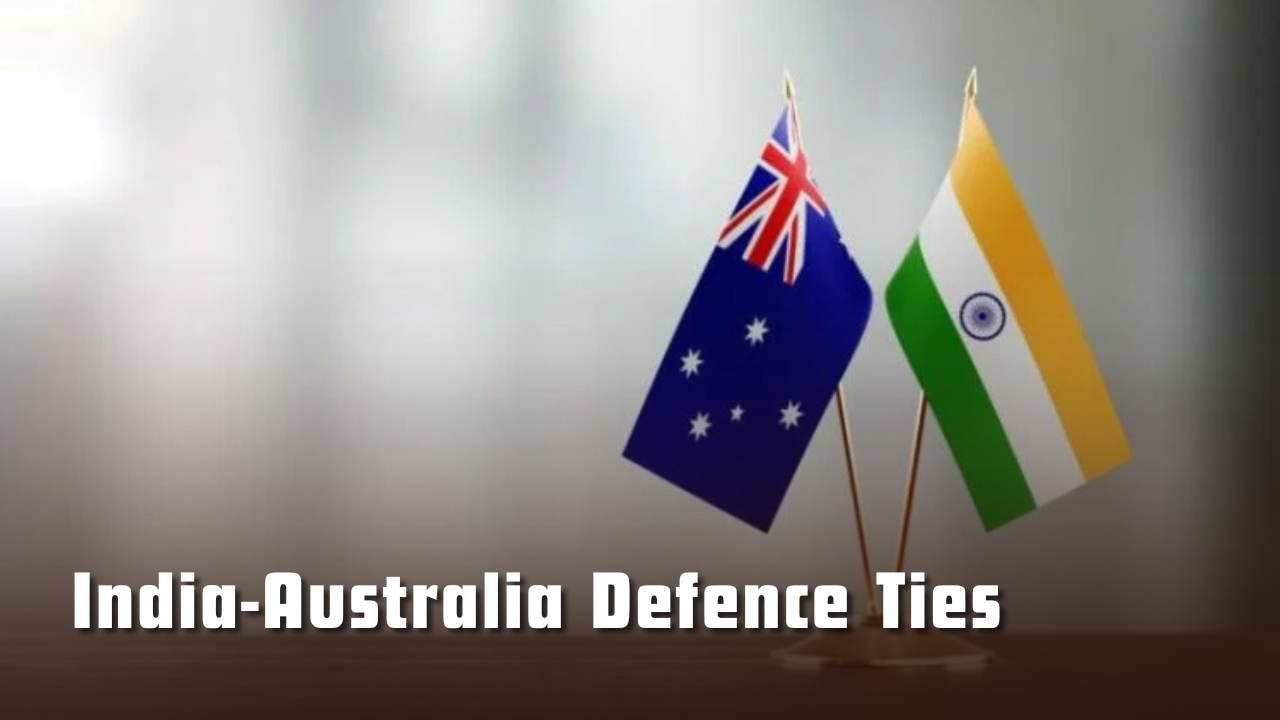Font size:
Print
India-Australia Defence Ties: Unlocking Strategic Synergy in a Divided World
India-Australia Defence Ties: Breaking New Ground Beyond U.S. Reliance
Context: The re-election of Donald Trump and his transactional security posture is altering global security alignments. In this changing landscape, India and Australia, as regional middle powers, find themselves uniquely positioned to enhance bilateral defence cooperation.
Strategic Convergence: The Basis for Deeper Engagement
- Australia’s geographic position bridges the Indian and Pacific Oceans, complementing India’s maritime strategy.
- The Australian Defence Force (ADF) has experience in coalition operations, aligning with India’s military capacity-building.
- Air-to-air refuelling arrangement (2024) illustrates growing operational synergy.
- Australia’s influence over Pacific Island nations aligns with India’s expanding diplomatic footprint.
- Both nations share a commitment to sovereign resilience and rules-based regional order.
Evolving Bilateral Frameworks and Institutions
- The Comprehensive Strategic Partnership (CSP) signed in 2020 created a strong political foundation.
- The 2+2 Ministerial Dialogue initiated in 2021 enables high-level strategic coordination.
- Agreements such as the Mutual Logistics Support Agreement (MLSA) facilitate joint operations and HADR missions.
- Key bilateral and multilateral exercises include:
- AUSTRAHIND (Army)
- AUSINDEX (Navy)
- Participation in Pitch Black and Malabar exercises
Limitations and Realities
- Neither India nor Australia can fully substitute the security void potentially left by the U.S.
- India is entangled in a continental security dilemma, with tensions along its northern borders with China and cross-border terrorism from Pakistan.
- Australia is engaged in a strategic transformation involving:
- AUKUS-led military modernisation
- Expanding influence among smaller island nations
- A reassessment of its regional role and defence posture
Five Strategic Priorities for the Next Phase of Defence Engagement
- Diversifying and Deepening Military Engagement
-
-
- Current cooperation is Navy-centric; needs expansion to Army and Air Force.
- Promote joint military exercises reflecting real-world scenarios.
- Establish a dedicated forum for Joint Staff Talks.
- Plan for a major combined military exercise within a decade to test interoperability and joint operational planning.
-
- Strengthening India’s Defence Footprint in Canberra
- Enabling Ground-Level Strategic Innovation
-
-
- Encourage bottom-up ideas from uniformed professionals and operational-level personnel.
- Move beyond diplomatic formalities in dialogues to focus on classified, operationally relevant discussions.
- Launch initiatives such as:
-
- Fellowships for staff college graduates
- Regular war-gaming exchanges
- Maritime Industry Collaboration and Capability Sharing
-
-
- Promote India-Australia cooperation in Maintenance, Repair, and Overhaul (MRO) of naval assets.
- India’s MRO capabilities are already proven with U.S. and British navies.
- Jointly manufacture and supply patrol boats to Indian Ocean Region (IOR) and Pacific island states.
- These collaborations foster technology-sharing, operational exposure, and regional capacity-building.
-
- Unlocking the Potential of MSME Sector and Defence Startups
-
- Indian OEMs often deal with parent companies in Europe or East Asia, bypassing local Australian arms.
- Cooperation in MSME and the startup ecosystem remains underdeveloped.
- Both India and Australia are pursuing defence indigenisation programmes — ideal for MSME alignment.
- Create a dedicated mechanism on the lines of INDUS X (India-U.S. defence startup platform) to promote joint R&D, dual-use technology development, and SME integration.
Towards a Future-Ready Partnership
- The evolving global order and uncertain U.S. commitments present a strategic window for India and Australia.
- Their complementary strengths, shared threat perceptions, and mutual interests in regional stability position them to emerge as critical security partners in the Indo-Pacific.
- Realising this potential requires a shift from dialogue to delivery, and from frameworks to field-level cooperation — thereby charting a course for an independent, resilient, and balanced regional security architecture.
Subscribe to our Youtube Channel for more Valuable Content – TheStudyias
Download the App to Subscribe to our Courses – Thestudyias
The Source’s Authority and Ownership of the Article is Claimed By THE STUDY IAS BY MANIKANT SINGH



